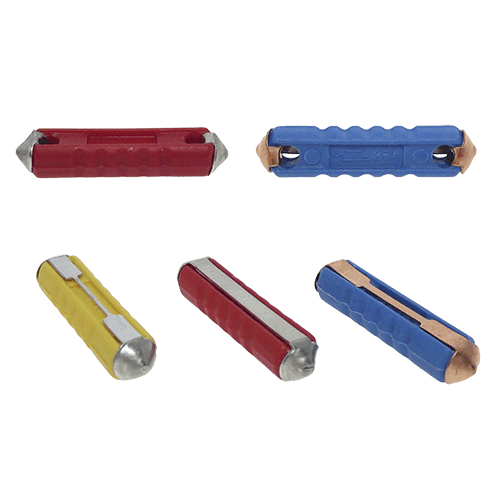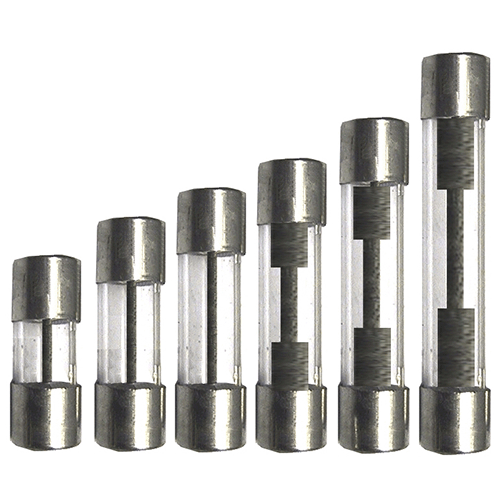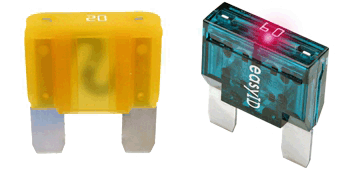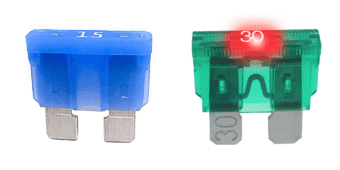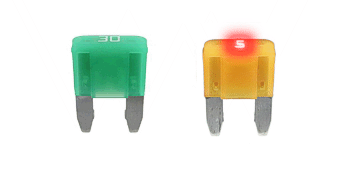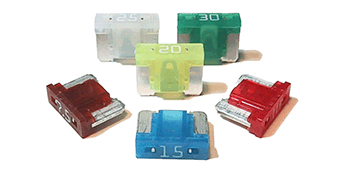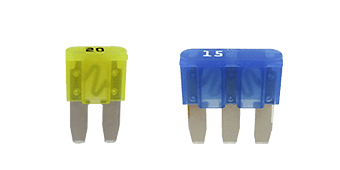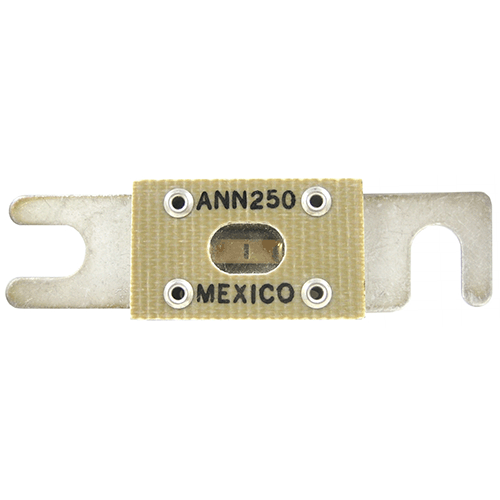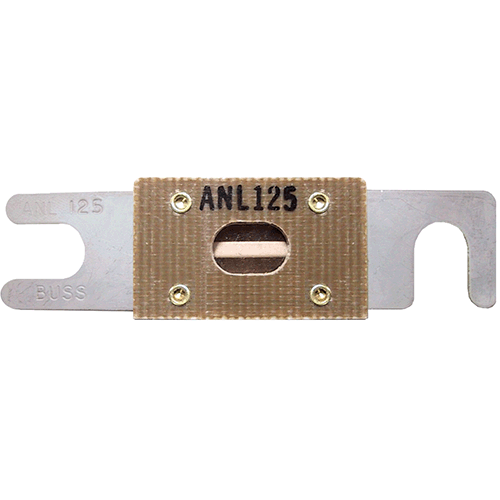Identifying Automotive & Car Fuse Types
Automotive fuses are extensively used in cars, trucks, buses and off-road transportation. They
are designed to protect the cables, wires and electrical components of the vehicle that supply
power to crucial electrical systems such as lights, heaters, air conditioning, radios, power
windows and more within your vehicle.
While the type of fuses used in your vehicle will differ based on the manufacturer and model of car you own, the introduction of the blade fuse (also called bladed fuses or spade fuses) in 1976 by Littelfuse has seen this fuse type become the most common fuse type used in vehicles since the mid 1980’s. If the vehicle you own was manufactured in 1986 or earlier it may use a different fuse type such as a Bosch Type fuse, Lucas Type fuse or Glass Tube Type fuse.
If you’re looking for a more general guide on identifying fuse types why not try our Guide to Identifying Fuse Types
While the type of fuses used in your vehicle will differ based on the manufacturer and model of car you own, the introduction of the blade fuse (also called bladed fuses or spade fuses) in 1976 by Littelfuse has seen this fuse type become the most common fuse type used in vehicles since the mid 1980’s. If the vehicle you own was manufactured in 1986 or earlier it may use a different fuse type such as a Bosch Type fuse, Lucas Type fuse or Glass Tube Type fuse.
If you’re looking for a more general guide on identifying fuse types why not try our Guide to Identifying Fuse Types
How to identify your vehicle's Fuse Type
In order to identify the type of fuse your vehicle uses you will likely need to inspect the fuse box located in the vehicle. However, certain fuse types are common to certain vehicles. Below are the most common fuse types used in vehicles.Blade Type Fuses
If you own a car manufactured after 1986, it likely contains blade fuses. These fuses are easily identifiable by their plastic body and two metal prongs. Despite nearly all petrol powered vehicles using a blade fuse type, they are available in six different sizes with current ratings ranging from 1 ampere up to 100 amperes.Bosch Fuses
Bosch fuses are common in old European cars. You can identify a Bosch fuse by the conical ends and the physical dimension size of 6×25mm. These fuses are also known as 6AC, GBC or Torpedo fuses. The Ampere rating is denoted by the colour of the fuse and follows 72581/1 DIN standards. If you own a 1980 or earlier european model of car, it may contain a Bosch fuse.Glass Tube Type Fuses
A variety of tube type (cylindrical) glass fuses were commonly used in American manufacturing of cars up until 1986. The majority of these fuses were 1/4 inch in diameter but varied in length and were designated with the AG suffix for 'automotive glass' eg. 1AG, 3AG, 7AG, 8AG, SFE fuses etc. These glass fuses were typically available in ratings of 1A to 30A.Whilst no longer commonly used in vehicles, Glass Tube Fuses are still manufactured for a range of different applications. If you own a car that was made in 1986 or earlier in Northern America, it may contain a Glass Tube Type Fuse.
Lucas Fuses
Lucas Fuses are predominantly used in older cars assembled or made in Britain. Lucas Type Fuses come in both a ceramic fuse and glass tube fuse. The ceramic fuse is easily identifiable by the canonical ends and is either 1 or 1.25 inches in length.Confusingly, the Lucas Glass Tube Fuses have different diameter sizes when compared to American Glass Tube Fuses . However, many Lucas Fuse Holders do accommodate their American Glass Tube Fuse counterparts.
If you own a 1986 or earlier British model of car, or car that was assembled in Britain and the fuse type is ceramic, you may need to look specifically for a Lucas Fuse.

How to locate your Vehicle's Fuse Box?
The Fuse Box of your vehicle can be located in several places and depending on the model, make or type of vehicle you own, there may be several Fuse Boxes.For most cars there are typically two Fuse Boxes; one located under the hood of the vehicle and the other located under the dashboard below the steering wheel. However, the easiest way to locate your Fuse Box is to consult your owners manual.If you don't have one for your car, usually a free copy can typically be found through a Google search.
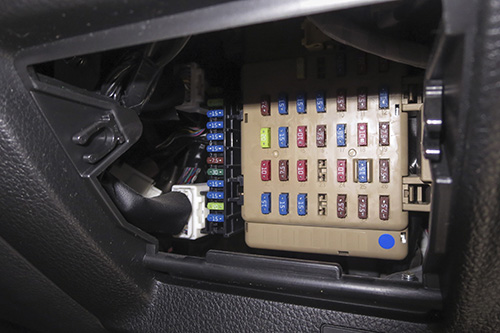
How to Identify your Car’s Blade fuse Type?
While there are 6 different dimensions of Blade Fuses, they are broken down into four main types.Each type has different size dimensions, making them easy to identify from one another. View our blade fuse size guide.
Maxi heavy-duty blade fuses
Maxi Blade Fuses are the largest type of blade fuse and can have a current rating ranging from 20 to 100 amperes. Maxi Blade Fuses are the largest sized Blade Fuse being 29.2mm wide, 34.3mm tall and 8.9mm thick. Another important note on Maxi Fuses is that the corresponding DIN colour for current rating differs at 25 and 35 Amperes, being Grey and brown instead of transparent and blue-green respectively.Regular (ATO/ATC) Blade Fuses
This was the very first blade fuse designed by Littelfuse and is still relatively common in many vehicles. Regular Blade fuses can have a current rating between 1 & 40 amperes and follow DIN colour standards. Their dimensions are 19.1mm wide, 18.8 mm tall and 5.1mm thick.Mini Blade Fuses & Low-Profile Mini Blade Fuses
Mini blade fuses are currently the most common fuse used in modern vehicles. There is also the low profile Mini Blade fuse which utilises the same pin spacing as the Mini Blade fuse, but has a smaller plastic body. Mini Blade fuses are 10.9mm wide, 16.4mm tall and 3.8mm thick. Low profile Mini Blade fuses are the same width and thickness, but only 8.73mm tall making them 7.5mm shorter in height to save space. Both of these fuse types are available in current ratings from 2 to 30 amperes.Micro 2 & Micro 3 Blade Fuses
The smallest blade fuse currently available is the Micro Blade Fuse. They are available with either 2 or 3 metal terminals (prongs). The two-prong Micro Blade Fuse is known as a Micro 2 fuse has a current rating range of 5 to 30 Amperes and is 9.1mm wide, 15.3mm tall and 3.8mm thick. The three prong Micro Blade Fuse is known as a Micro 3 Fuse and is available in current ratings of 5 to 15 Amperes. The dimensions of the Micro 3 Fuse are 14.4mm wide, 18mm tall and 4.2mm thick.The Micro 3 Fuse is designed to protect 2 different output circuits from a single power source. Power flows into the fuse via the middle prong and out via the 2 outside prongs. The fuse ampere rating applies to both output circuits.
Limiter Fuses (Current Limiting Fuses)
Limiter Fuses or Current Limiting Fuses feature an internal fuse element that melts when current passing through the fuse element is within the specified current limiting range of the fuse. As the fuse element melts, it creates a high resistance to reduce the magnitude and duration of the current flowing through the fuse to protect the electrical circuit and connected equipment.Current limiting fuses come in all shapes and sizes to suit many different applications, however Bussmann make a range of Limiter Fuses specifically designed for use in battery operated lift trucks or forklifts. The ANN very fast acting fuse and ANL non-time delay fuse. Both these fuses feature slots in the fuse tag for a secure bolt down mount and available in a range of ratings from 10 to 800 amperes.
While there may be many reasons you may need to identify the fuse type of your vehicle, the
most common is for fuse replacement. It’s important to note that a blown fuse may be a sign of a bigger
problem with your vehicles’ electrical system and you should always consult with a qualified
mechanic to ensure that it is operating safely to avoid placing yourself or other people in danger.
You can view our full range of Automotive Fuses here or contact our friendly staff today if you need further assistance identifying the type of automotive fuse you need.
You can view our full range of Automotive Fuses here or contact our friendly staff today if you need further assistance identifying the type of automotive fuse you need.






